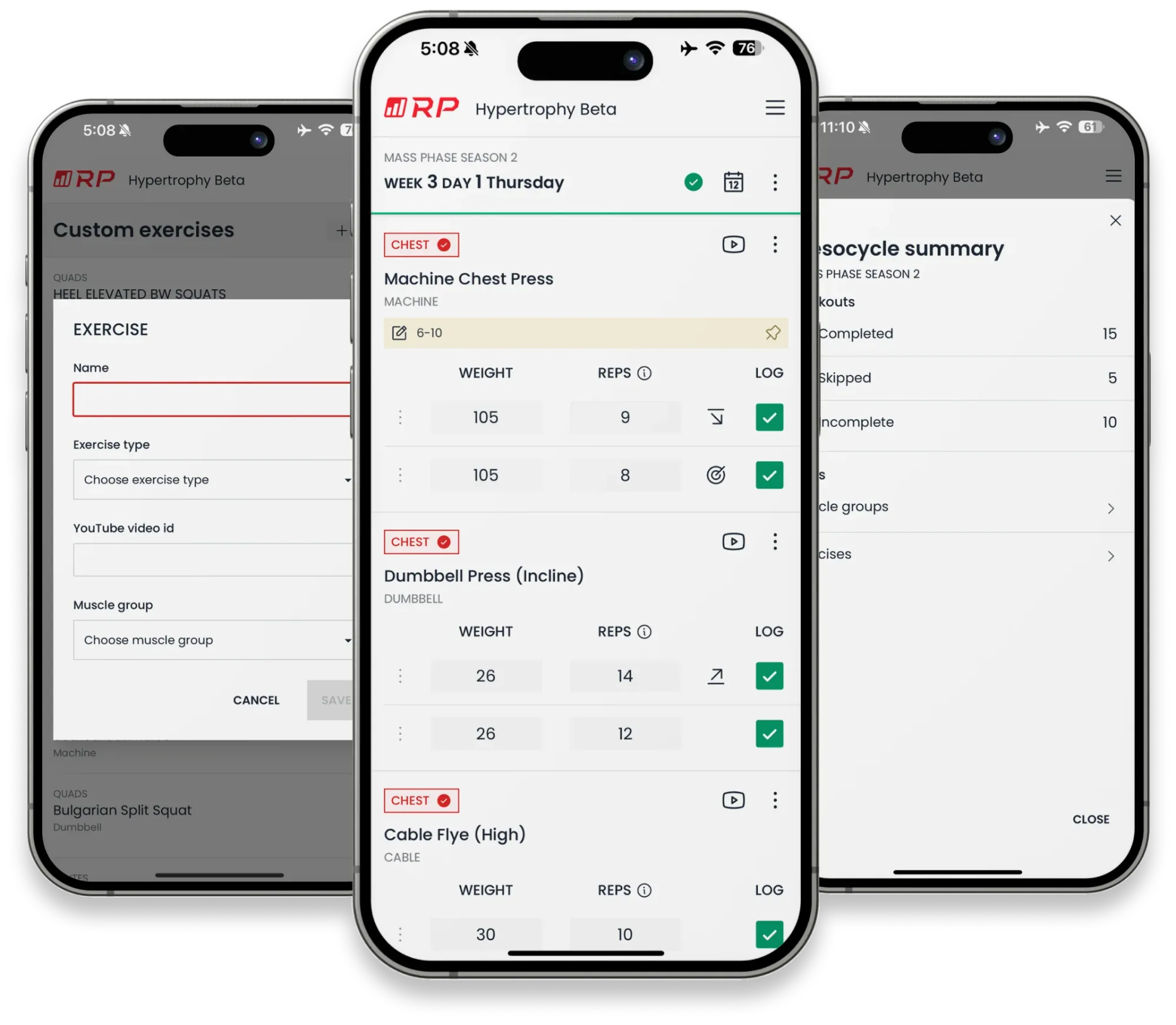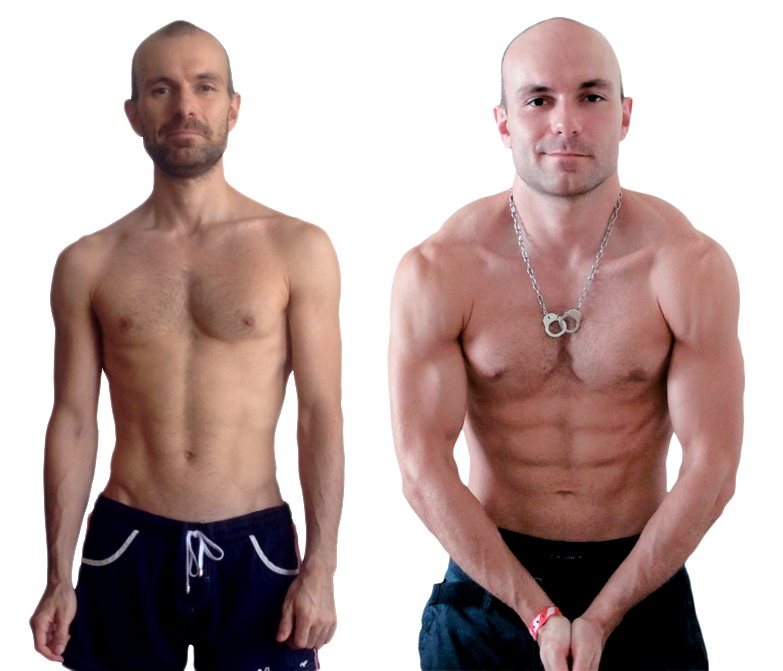Independent RP Hypertrophy App Review by Expert 2025
An honest look at the features, pros and cons, and user reviews of the RP Hypertrophy App

Key takeaways
- Built for hypertrophy: The RP App is focused on muscle building
- Gradual adjustments: You are guided with progressive overload, ramping up volume and weights, and cutting down reps in reserve over a 4-6 week cycle—followed by a deload
- Web-based: Not an actual mobile app—no offline use, no public ratings
- Ratings. For reference, the RP Diet App is rated 4.5 on the App Store and 4.4 on Google Play, while RP stands at 2.8 on Trustpilot
- Not beginner-friendly: While some find it effective, others grapple with the learning curve
- Controversy: Scientists question the superiority of RP's approach
- Pricey: At $34.99 per month or $299.99 per year, some users can't justify the cost for value. There are free alternatives
Looking for an independent review of the RP Hypertrophy app? You've come to the right place.
This app's got some serious muscle behind it—including exercise scientist Dr. Mike Israetel, a famous name in the industry.
The app promises a science-backed approach to hypertrophy training. But is it truly worth the investment for those serious about muscle growth?
Let's find out.
In this honest review, we'll break down:
- What's under the hood?
- The good, the bad, and the ugly
- Does it actually work?
- Is it worth the cost?
- What are real users saying?
Plus, to help you make an informed decision, we'll see how it compares to other popular workout apps, including free alternatives.
But before we start, I want to disclose that I'm a little biased.
Why trust this review?
I've got skin in the game:
- I’ve been a lifter and a coach for 20 years, and a trainer for the Canadian Forces.
- I'm also an exercise scientist with a PhD in health statistics.
- I’ve helped about 10,000 people get in shape 1-on-1, in group classes, and online.
- I walk the walk, being in decent shape myself. I even overcame personal health setbacks, gaining 27.7 lbs of muscle at 5'7" naturally.

But full disclosure: I've worked with Dr. Mike Israetel before. We wrote a scientific paper and a series of blog posts together. As an exercise scientist, I'm also a big fan of his YouTube channel. He cracks me up, and I like the guy.
On top of that, in 2016, I finished my PhD, gathered a small team, and started building Dr. Muscle, the world's first AI personal trainer.
Imagine ChatGPT, but for lifting. Automated yet personal, with expert coaching and workouts unique to you—optimized to help you build muscle and strength faster, on autopilot.
In a way, we compete with the RP app, so you might expect me to bash them. But here's my promise:
Despite potential bias, I'm committed to an honest, balanced review. You'll get the facts, good and bad, so you can decide for yourself.
This isn't about bashing a competitor. It's about giving you the straight scoop on the RP Hypertrophy app.
I value honesty, and wanted to disclose all of this in the spirit of transparency before we jumped in.
Ready?
RP Hypertrophy App Review
Let's break down the pros and cons of the RP Hypertrophy app:
Pros:
- Individualized Training: The app adjusts your training volume based on self-reported data like "quality of pump" and soreness1.
- Focus on Hypertrophy Variables: It evaluates your training based on factors relevant to muscle growth: pump, soreness, perceived effort, and progressive overload2.
- Promotes Progressive Overload: The app guides you to increase volume, weight, and decrease the Reps in Reserve (RIR) over a 4-6 week wave and then deload2.
Cons:
- Cost: At $34.99 per month or $299.99 per year, the app is quite pricey, and some users have stated that they can't justify the cost for the value it provides2.
- Offline Usage: The app can't be used offline, which might be inconvenient if your gym doesn't have perfect reception2.
- Limited Features: Some users have mentioned that the app could benefit from additional features such as a plate calculator or warm up calculator2.
- Short Mesocycle: The app's 4-week mesocycle might be a bit short, and users have found they need to manually add sets especially when the app suggests only one set for a body part2.
- Incomplete: No personalized programs, no rest periods prescribed, and minimal help, if any, with choosing exercises. Learn more in this in-depth, 13-point training critique.
13-Point Training Critique & Review
Another exercise scientist writing for this blog, Garett Reid, MSc, penned a 13-point training critique of the RP app.
Read it or learn more in his video review:
User Reviews
I've been checking out what people have to say about it. Here's the scoop.
- Users have said that the app is good at evaluating their training based on variables that matter for hypertrophy: pump, soreness, perceived effort, and progressive overload12. Indeed, the RP Hypertrophy App uses self-reported data like your "quality of pump" and soreness to adjust your training volume.
- People seem to like it, but it's not all roses. A few users have suggested tweaking the app's 4-week mesocycle to 5 or 6 weeks for better results1. One of the things they like is that the app allows you to manually add a set or two if needed. But be careful, don't go overboard1.
- Other users have praised other features of the RP Hypertrophy app, like its periodization element1.
However, the RP Hypertrophy app isn't without its downsides.
- The RP training methodology is built on theoretical ideas (no hard evidence) and may overly complicate muscle growth.
- There's also been some debate about whether it's really an "app". It's hosted on a website, so you need an internet connection to use it. Not ideal if your gym has spotty reception1. It's also been described as a web interface with the book/templates and their rating system, rather than a traditional mobile app1
- Another point to consider is the app's simplicity. It's basic-looking and doesn't offer a wide variety of exercise choices. This might be a drawback if you prefer a more robust or visually appealing interface1.
- The price tag is another issue. At $20 or $25 per month [now $34.99], some users find it too steep for their liking1. One wrote "Paid for one month... totally not worth it" (see below).
Comment
byu/nonstop_feeling from discussion
inStrongerByScience
App Store Ratings
The RP Hypertrophy App is actually a Web-based platform. Not a "real" mobile app.
So, it's not available on the App Store or Google Play, and there are no aggregate ratings. This makes it hard to tell how much users enjoy the app, and if it's worth it's relatively high price.
Speaking of which, if you're on a budget, you can check out these 5 free alternatives to the RP App.
But to give you some context, I managed to find the following ratings for RP:
- Their RP Diet App is rated 4.4 on Google Play and 4.5 on the App Store.
- The publisher, RP Strength, is rated 2.8 on Trustpilot and 3 on the BBB.
Take these ratings with a grain of protein powder, as they're not for the Hypertrophy App itself.
Controversy Around RP Hypertrophy Progression
If the RP Hypertrophy App is to be any good, it has to be based on sound exercise science.
Especially when it comes to progressive overload.
This is where the controversy begins.
Problem is, the team at Renaissance Periodization are basing their hypertrophy app on their unique approach to progression.
But many trainers believe it not necessarily optimal, including noted exercise scientist Dr. Eric Helms, PhD.
This sparked a debate hosted by Steve Hall of the Revive Stronger podcast.
You can watch it here:
RP Hypertrophy App Alternatives
When considering alternatives to the RP Hypertrophy App, it's essential to highlight where other options shine.
| App Name | Focus Area | Unique Feature |
|---|---|---|
| Dr. Muscle | AI-driven hypertrophy | Personalizes and adapts workouts in real-time |
| Strong | Workout tracking | Simplistic, efficient workout logging and analysis |
| Fitbod | Customized workouts | Tailors workouts based on equipment and recovery |
| StrongLifts 5x5 | Strength program | Focuses on compound lifts and progressive overload |
| JEFIT | Exercise library | Extensive customization and tracking capabilities |
First, call me biased, but I think Dr. Muscle stands out with its advanced AI technology, offering personalized workout plans that adapt in real-time to your progress, similar to having a digital personal trainer. This unique feature caters to individuals at any fitness level, optimizing workouts for muscle growth and strength gains efficiently.
Strong, another excellent alternative, focuses on workout tracking and analytics. It's perfect for lifters who value simplicity, efficiency, and the ability to customize their workout routines. With its intuitive interface, Strong helps users track their progress, set goals, and visualize improvements over time, making it a valuable tool for anyone looking to enhance their training outcomes.
Fitbod is also a worthy mention that creates personalized workout plans based on your equipment, goals, and performance. It's particularly beneficial for those who prefer variety in their exercises and need guidance on how to effectively use their available resources.
StrongLifts 5x5, focusing on simplicity and strength, is ideal for beginners or those who prefer a straightforward approach to gaining strength and muscle. Its emphasis on heavy compound lifts promotes hypertrophy through progressive overload.
Lastly, JEFIT offers an extensive exercise library and customizable workout routines, appealing to users who enjoy tailoring their fitness journey and tracking their progress with detailed analytics.
Alternatives for Your Goals
So, which one should you choose? Each alternative to the RP Hypertrophy App brings its unique strengths to the table. To sum up:
- If you're looking for personalized, AI-driven hypertrophy workouts that evolve with your progress, Dr. Muscle might be your go-to.
- For those who prioritize tracking, analytics, and customization, Strong could be ideal.
- Fitbod offers variety and adaptability, perfect if you enjoy workouts tailored to your available equipment and goals.
- If simplicity and a focus on strength and compound lifts appeal to you, StrongLifts 5x5 is worth considering.
- Finally, for enthusiasts who like to meticulously plan and track their fitness journey, JEFIT stands out with its extensive exercise library and customizable routines.
The choice depends on your specific needs, preferences, and fitness goals.
Is the RP Hypertrophy App Worth It?
So, what's the bottom line?
The RP Hypertrophy app offers a unique approach to muscle building. It has its strengths, like a focus on hypertrophy and individualized adjustments. But it also has its weaknesses, like offline usage, cost, and training limitations. It might be good for pure hypertrophy, but it might not be the best fit for everyone's budget or training preferences1.
Is it worth the investment? The jury is still out. Some users love the training style and content, but think it's possible to achieve similar results with self-programming1. Some professionals have also critiqued RP's training methodology.
Looking for an established, powerful, and free alternative? Try Dr. Muscle. Of course, we're biased. But we believe the results hundreds of users have gotten so far speak for themselves.
In the end, do your research, consider your needs and goals, and make the choice that's right for you. Remember, the best training program is also the one you'll stick with.
Stay strong!
